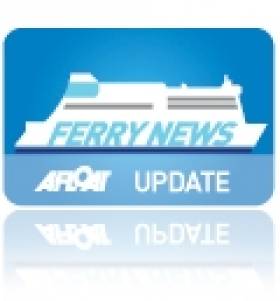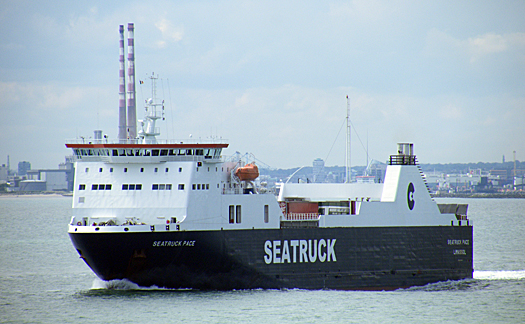Displaying items by tag: Ferry Captain Interview
#FerryCaptainInterview - Starting from last weekend is our new series of interviews with Irish Sea ferry captains. Jehan Ashmore talks to Captain Phil Ankers, master of Seatruck Ferries 'P' class ferry freight, Seatruck Pace which in late April entered service on the Dublin Port-Heysham service.
The larger 110 trailer-unit vessel replaces a smaller vessel on the route linking the capital and Lanchashire port. Her introduction also brings enhanced facilities for driver-accompanied trucks on the eight hour Ireland-UK link and offering 16 weekly departures to meet the demands of hauliers.
Before her recent return to Irish Sea, the vessel built as one of a quartet for Seatruck Ferries, had been chartered to Bluwater Shipping A/S to transport wind-farm components from Esbjerg in Denmark for the construction of the Gwynt y Môr Offshore Wind Farm off north Wales.
What set your interest to choose a seafaring career?
There had been seafaring in the family but it skipped a generation with my father, before him there had been two generations of marine engineers!
Name the colleges and or academies to where you studied seamanship courses?
For first certificate (2nd Mates) I studied in Riversdale College in Liverpool then for mates and masters, I studied in Liverpool Polytechnic.
Did any of these educational institutions involve using a training ship? or a stint of service on board a vessel as part of the programme module?
To get 2nd Mates you required 18 months sea service so we had 2 x 6-months in college and the rest spent at sea.
Seatruck Pace on her morning sailing departing Dublin Bay bound for Heysham in Lancashire
Upper-deck of the 110 freight-unit (2,930 lane metres) larger 'P' class vessel which was introduced on the Irish Sea route in late April
What was the most interesting and also the most challenging aspect of your studying?
Ocean fleets traded worldwide so there was a good variety of interesting runs. Star sights were probably the more satisfying part, learning all law and construction was challenging.
For what reasons did you like a career in deep-sea and what ship was the most rewarding?
At the time you could go away to see the world as you had a little port time and shore-leave to do so. My first voyage to the Far East on 'Ascanus' then 'Glenlyon' were very good.
How many un-accompanied trailers can be handled (types of cargo) on the freight decks?
In total there are 116-trailers or 10 trucks and 12 self-drives (cars or lorries).
Since refurbishment upgrade, what facilities have improved for truck ferries and private motorists?
These Point ('P' ) class ships have offered very good facilities since launch, having private cabins with own-shower's +T.V. in addition a good drivers' mess lounge. The new FSG class of the 'Power' and 'Progress' are now much improved as they have privacy curtains and no bunk beds.
What nationalities make up the crew and how many are there in total between change of rosters?
On here we have 3, masters are British, chief officers are Estonian and all other ratings are also of the same nationality. In total we have 40 members of crew.
On average what is the speed of the vessel on the Irish Sea route?
Around 15 knots, the ship can achieve up to 20 knots but we average approximately 15 knots for economy service.
In terms of fuel, what capacity is consumed on each passage and how often do you need to take on bunkers?
The vessel consumes between 9 and 16 tonnes depending on one or two engine passages.
How often do you go on leave while your fellow counterpart relieves you on duty?
We work 2 weeks on 2 weeks off and this changes to 3 on and 3 off during the summer months.
What aspects do you enjoy the most on the freight-only service?
I have enjoyed passenger runs as well but we can give a more one-to-one service on this route for our 12 passengers, which can be for driver-accompanied trucks, private car motorists and those taking motorhomes.
How well suited is this ro-pax on the route and her sea-keeping handling?
This vessel is well suited to Irish Sea conditions.
Captain Phil Ankers on the bridge approaching berth at Dublin Port and a 'FSG' class ship serving Seatruck's route to Liverpool
#FerryCaptainInterview - In our first of a series of interviews with Irish Sea ferry captains, Jehan Ashmore talks to Captain Allan Albiston, master of the Isle of Man Steam Packet Company's ro-pax ferry Ben-My-Chree, the Manx for 'Girl of My Heart'.
Captain Albiston's career has spanned more than four decades and his current command of the 600-passenger and vehicle ferry is principally employed operating the main link to the UK between Douglas-Heysham. In addition to running during the winter months to Birkenhead and on occasions of the seasonal-only service to Dublin Port.
Since entering service in 1998, the Dutch built ferry of 12,504 tonnes has been the workhorse of the company. She recently re-entered service fresh from an overhaul and refurbishment costing £1.6m to enhance passenger facilities and for those of her crew.
What first inspired you to thinking of having a career at sea?
My mother was born in the Isle of Man and so as a child I spent summer holidays on the island travelling by boat.
I spent my school summer holidays working on the rowing boats in Douglas and when I was old enough, as a steward on the last Ben-My-Chree between 1969 – 1971. Seven years later in 1978, I returned to the Steam Packet Company as a second officer.
Has there been an individual or seafaring background that has influenced your career?
My mother's family had fishing boats in Laxey during the early part of the 20th century so I guess it was in the blood somewhere.
What college did you attend?
I studied at the Fleetwood Nautical College.
The Isle of Man Steam Packet Company's ro-pax ferry Ben-My-Chree
The onboard Coast to Coast Cafe
What companies have you served and trading routes or regions?
For seven years served as as cadet and third officer with Andrew Wier (Bank Line) trading Worldwide to Africa, India, North & South America, Asia, Australia, New Zealand and Pacific Islands. Also had two winters with Manchester Liners trading to Montreal and to the Mediterranean Sea.
It was great fun seeing lots of the world in those years, but I wouldn't want to do it today. It's all about visiting container ports and oil terminals miles away from the city ports we used to visit.
Name the first ship that you took command?
The first vessel I took command of was the fast-craft ferry, Seacat Isle of Man.
What is your weekly routine in terms of managing crew operations of Ben-My-Chree?
The day to day running of crew operations is carried out by the heads of department, the Chief Engineer, Chief Officer and Passenger Services Officer – that look after their areas but as master, I am in overall charge of everything and everybody on board - it is all encompassing and ultimately I am responsible for all safety and crew training.
What aspects do you like serving on a multi-purpose ferry?
As Master, the vessel type is not as important as the route and schedule. The advantage of short sea routes means that regular leave periods, allows for a reasonably cohesive home life which is not enjoyed by mariners serving in deep sea trades.
What reasons make the ro-pax ferry suited to this short service on the Irish Sea?
It gives car and foot passengers an opportunity to travel from the Island twice a day 364 days a year which would not be possible with a split passenger / freight service.
Since her recent biennual overhaul, what has improved in terms of passenger facilities?
The main passenger lounge, the Coast to Coast Café, has been upgraded and is much brighter and airier giving a feeling of more space. The Legend's Bar area has also benefitted from new seating.
How many crossings does the ship make while working on the main link between the island and the UK mainland?
Apart from a routine maintenance night once a month and Christmas day, the vessel sails 28 crossings every week of the year, two in each direction daily.
Asides the Heysham-Douglas route, which seasonal operated route do you like to serve on across the Steam Packet network and why?
As senior master on Ben-my-Chree, the latest vessel to bear this famous 'steam-packet' name, I rarely do other routes apart from Birkenhead during the winter months.
People may not think there is much excitement sailing from Douglas to Heysham every day, with the occasional trip to Birkenhead, but there are lots of challenges.
Last winter we had atrocious weather, which was very challenging, and we sometimes have other problems to resolve as well as crew and customer issues to deal with on sailings, so there are plenty of challenges on a day-to-day basis.
When I was Master on the fast craft, which I commanded from 1997 until 2010, I liked the variety of operating different routes rather than having a specific favourite.
From a scenic perspective, the Belfast route was more interesting as we sometimes go south of the Isle of Man and sometimes north depending upon tidal conditions.
On leave, what are your favourite activities and pastimes?
I have a secondary occupation doing safety management for a large yacht company and this takes me to the Caribbean in winter and the Mediterranean in summer but I have also been to Australia and Brazil.
Travel abroad both for work and family holidays continues to be my favourite pastime with a couple of ski holidays thrown in.



































































